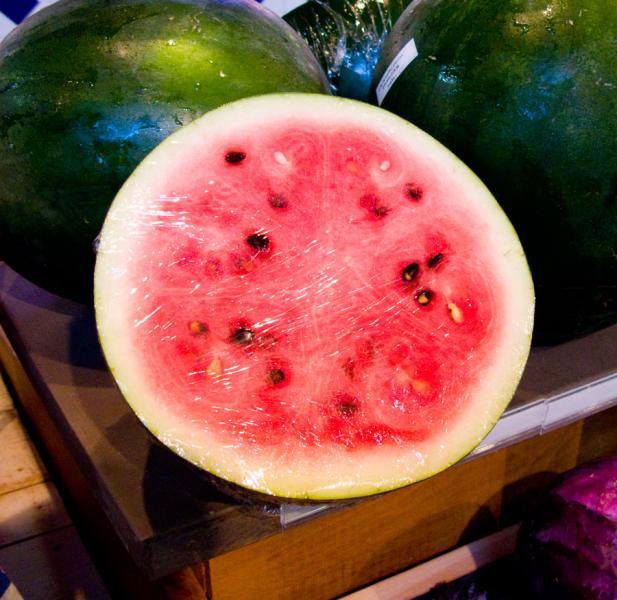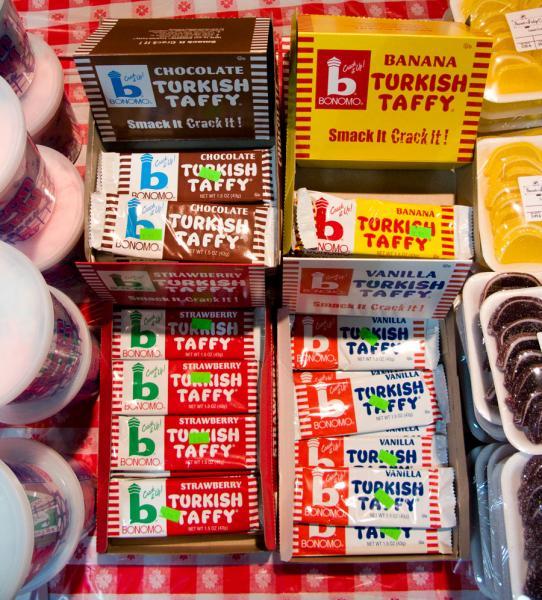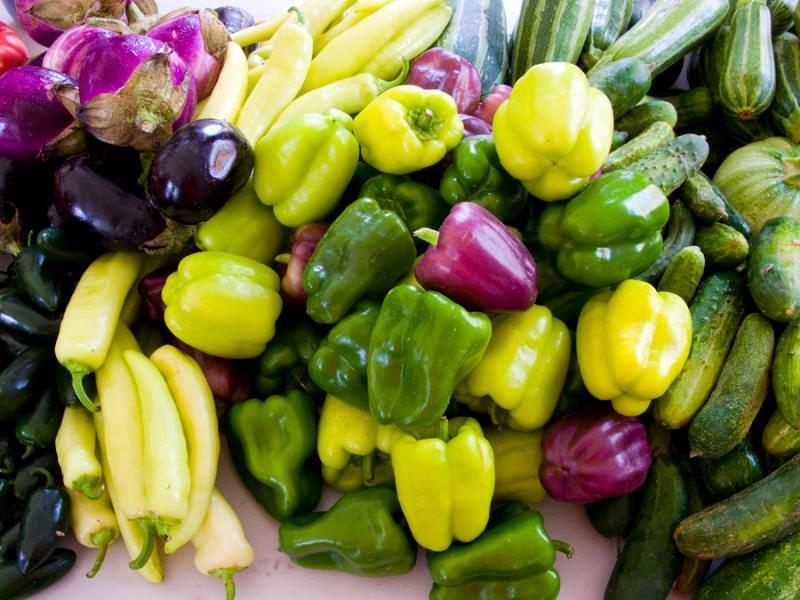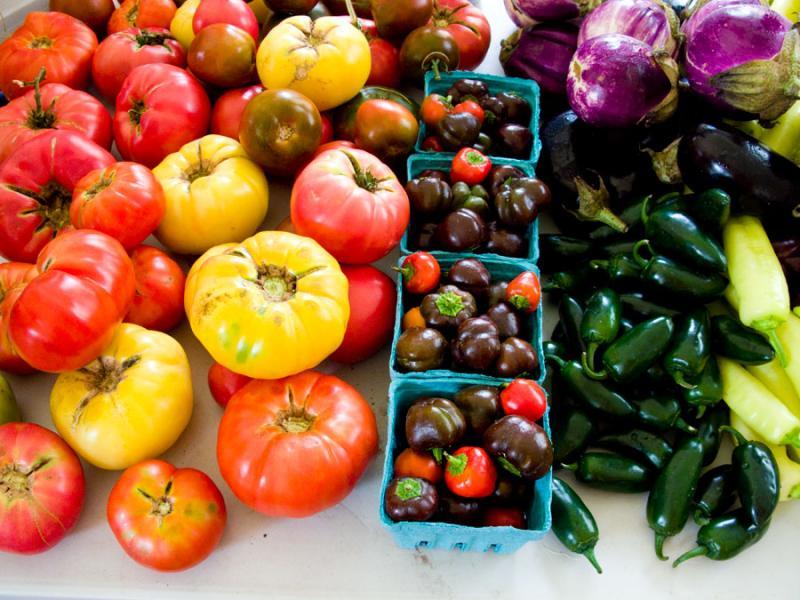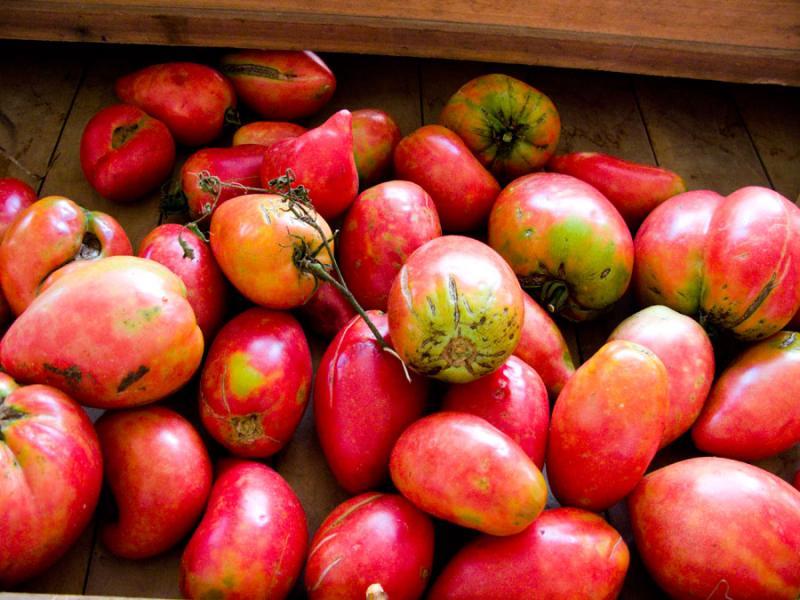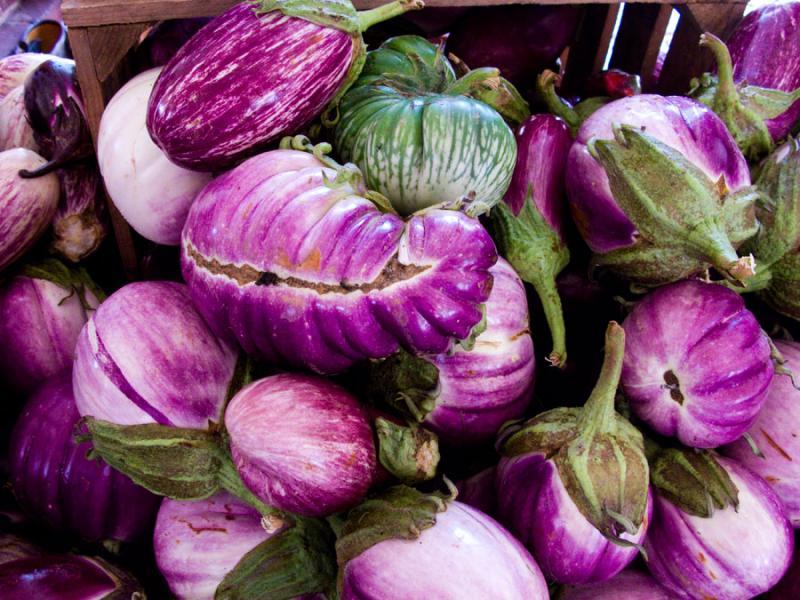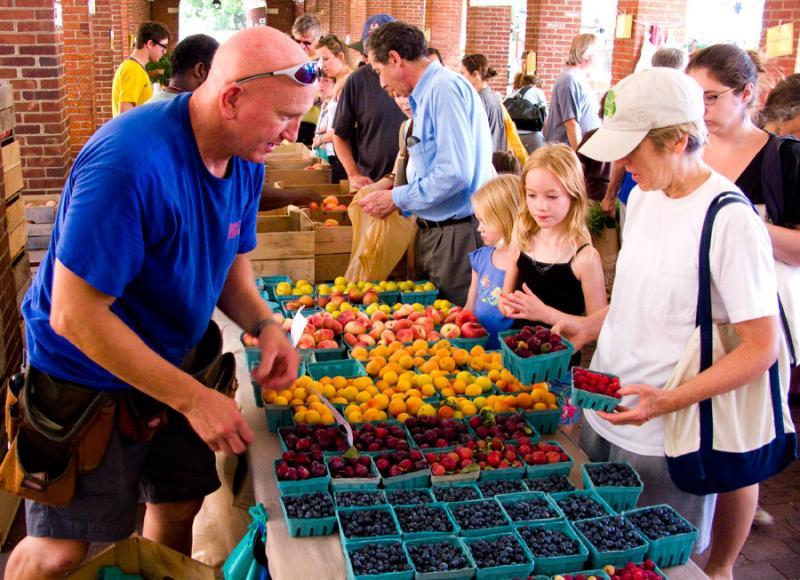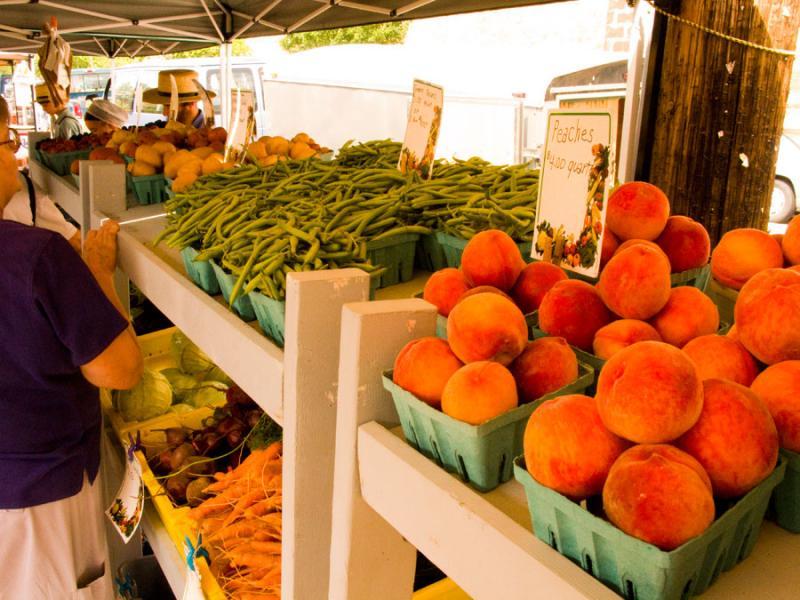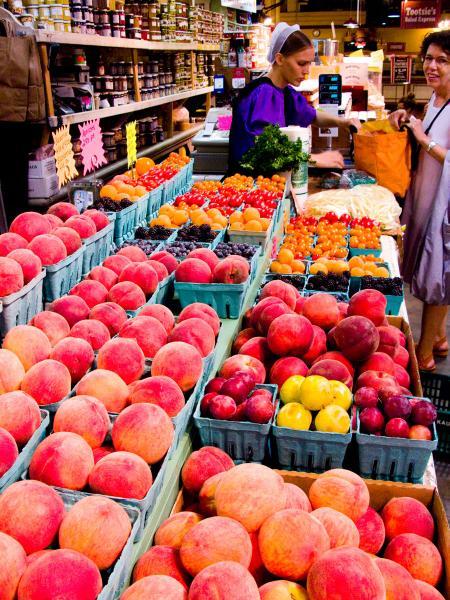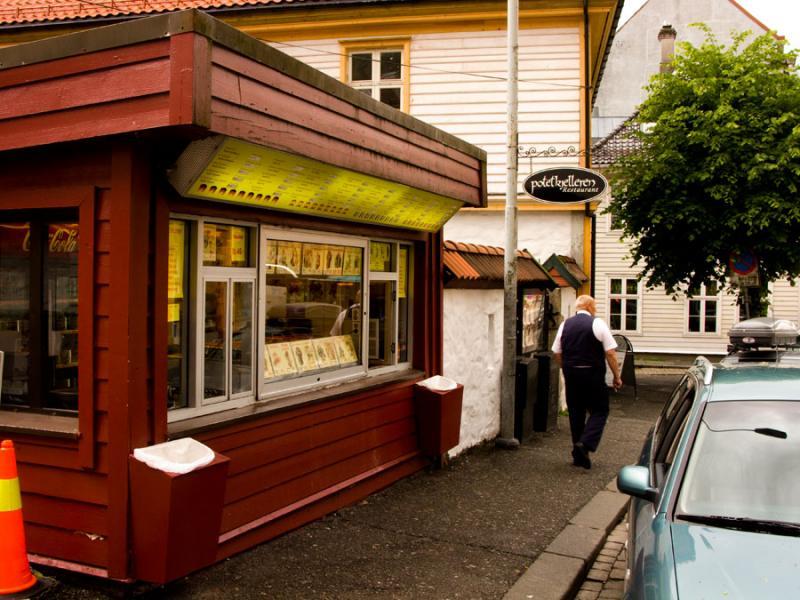-
Posts
3,022 -
Joined
-
Last visited
Content Type
Profiles
Forums
Store
Help Articles
Everything posted by rlibkind
-
Elizabeth Halen, who's been blogging about baking and other food topics over at Foodaphilia, can't resist the urge to turn avocation to vocation. So she's bought the Reading Terminal Market outpost of Flying Monkey Patisserie. The seller, Flying Monkey founder Rebecca Michaels, plans to continue to operate the cupcakerie at 1112 Locust St. Halen doesn't officially take over until Oct. 1, but she can frequently be found at the center court stall now. She plans to expand beyond the cupcakes, brownies and bar cookies in the current offerings. You might want to check out the recipe list on her blog to get an idea of the possibilities.
-
I think browning is more important for the look of the meat than the flavor, though it does add some to the sauce. You can cook a stew/braise without browning and it will be perfectly fine, perhaps not quite as flavorful, but it can still be delicious, all other things being equal. I went back to double-check my Bittman recipe (via the iPod/iTouch app) and see if, indeed, he does call for 90 minutes. Yup! He even says timing after initial 30 minutes can be 30-60 minutes more, i.e., total braising time of 60-90. Maybe a one-inch cube might cook that soon (his recipe calls for one to one-and-a-half inch cubes), but that's not been my experience. I've been using Harold McGee's technique for a couple years (browning, then putting into cold oven). McGee says to quickly sear pieces a minimum of an inch per side, then into the cold oven, turn it on to 200 F and let it cook for two hours, then increase heat to 250 for another hour, at which time you begin checking for tenderness. Once cooked, let it sit outside the oven in its braise to cool, allowing it to reabsorb some of the liquid. Then make a sauce. Great for making in advance and sticking in the fridge, then gently reheating for serving (you can microwave at a low setting with no harm). According to McGee, too high a heat dries out the muscle fibers. And the low temp for a sustained time allows the collagen to soften into gelatin, giving you that great mouth-fee. btw, outside of carbonnade, where I use beef, much of the time I'll braise veal (breast, shoulder or leg); Bittman has a great recipe for a veal braise that calls for not much more than riesling as the braising liquid, though I usually add a bit of shallot.
-

St. Louis Restaurants: Reviews & Recommendations
rlibkind replied to a topic in The Heartland: Dining
Wow! How long has Forgione been in STL? Is he there cooking? Seems like I've read he's mostly doing consulting these days, but his NYC restaurants were outstanding, including the original The American Place. -
If the procedures you outlined above are the ones you usually use and it works fine, please disregard the following comments. What seems unusual to me is the fact that you're browning it fully submersed in oil. If the oil is hot enough not to be significantly absorbed by the meat, it's too hot which means you're overcooking the beef even before you start. If it's not hot enough, the meat absorbs too much oil. You don't want the browning process to do much if any cooking; rather, it just provides the beginning of the maillard reaction to produce and intensify flavors. To my mind, you're cooking a soup rather than a stew if the liquid is totally covering the meat: too much of the flavor goes into the liquid and not enough retained in the meat. What you really want is a braise, with liquid coming maybe halfway up the height of the meat. Of course, the problem may have simply been the meat, or rather, the individual animal that provided it. Beef of the same cut and grade can be completely different animal to animal. As for timing, depending on how much meat you were cooking and the form and size of the pieces, 90 minutes may not at all be adequate. Many of the braises I do, usually involving 2-3 pounds of meat, take two to three hours in the oven (starting by putting the covered pot [cover slightly ajar to help prevent boiling] in a cold oven and setting temp to 200 for first 90 minutes then raising to 250 until done). Be careful not to overcook, though; that actually dries out the meat. As soon as you can easily puncture the meat with a fork or knife tip, it's done.
-
Why not frozen? There's absolutely perfectly fine frozen Alaska halibut or chinook (king) or red (sockeye) salmon. It's frequently better than a fishmonger's "fresh" (unless you live in Alaska). I'd just try to avoid frozen that's labeled product of U.S. But processed in China. If you still want to deal with fresh, buy on Friday and make a mousse, hold in fridge. .
-
Not either/or. Many (Beechwood orchards, Fahnestock Fruit Farm, to name just two) sell at venues sponsored by both.
-
The Reading Terminal Market plans to acquire Farm to City, which operates about a third of the region's farmers' markets, including Rittenhouse Square, South & Passyunk, and Fairmount. FTC, chartered as a for-profit limited liability company, would be dissolved and its staff, including founder Bob Pierson, become RTM employees. Pierson says the benefits would be (1) co-branding the farmers' markets to an existing icon of the Philadelphia food world and (2) open program funding opportunities by becoming part of a non-profit organization. For those interested in more detail, read about it here.
-
Agreed. How do feel about the fat from older sheep, compared to the meat? That wouldn't have been my 1st choice -- can you elaborate? Alas, I've had little opportunity to try mutton: pretty hard to find here in Philadelphia, though pinnekjott, a Norwegian Christmas dish of dried ribs which I have made, comes from older animals. As for chicken feet, well, I find they just have an intense chicken flavor. That's probably why any grandma who is a good cook, whether Jewish, Italian or Chinese, puts a couple chicken feet into the pot when making stock. Plus it adds gelatin for mouth-feel. The only other chicken preparation that competes in flavor intensity would be gribenes, which is what you've got left when you've rendered chicken fat from chicken skin (and have thrown in a tiny bit of onion).
-
Warning: this post is not for those who insist on healthy eating at all times. But if you're adventurous, and enjoy an occasional indulgence with absolutely no redeeming qualities other than taste, read on. First, you must like lamb. Because lamb fat is essence of lamb, just as chicken feet are essence of chicken. That's why I like both and, for the first time in more than a decade, feasted on lamb fat for dinner Saturday. I've loved lamb fat since I was a kid, when my mom would make barely trimmed rib lamb chops only in the summer when she could use the backyard grill because she hated the smell. But my father and I devoured them. I rekindled that love in Jerusalem about ten years ago at a shashlik joint called Shemesh Quick Bar on Ben Yehuda Street. They also served grilled goose fat along with more traditional kebab meats. The lamb fat for Saturday's feast was procured from Martin's Quality Meats at Philadelphia's Reading Terminal Market. I intended only to get some double-thick lamb rib chops, asking the butcher not to supply me with one of the puny, bulemic Frenched chops displayed out front in the case but cut some afresh, leaving plenty of fat. What he brought me had some fat along the bone, but not nearly enough to my taste. "I love lamb fat," I told him. So he took out another set of ribs and cut off the fat in a sheet of about nine inches square and a few smaller pieces, wrapped them and handed to me gratis, noting that he left traces of meat within the fat slabs. (Normally these trimmings simply go into the discard bin.) Once home I unwrapped the precious package and cut the fat into strips about an inch wide, discarding the ragged ends. How to cook? I knew I wanted to use my grill, but worried about the strips falling through the grates. I didn't want to lose one delicious morsel. So I took out three banboo skewers, about eight inches long or so each, and threaded three strips onto each. I chopped some fresh rosemary, pulverized four or five garlic cloves with kosher salt, and mixed it all together with fresh ground black pepper, then smeared it wantonly over the skewers and chops. I let it all sit for the 10 or 15 minutes it took to bring the grill to heat. As anyone who has cooked lamb chops over direct grill heat knows, the more fat the higher the flames, raising the odds of winding up with pure carbon for dinner. Fortunate that my Weber gas grill has three burners, I put two of them to high heat and the third rear burner on low. Once everything heated up, and greasing the grates with a square of the excess fat, I started out with the skewers on the back burner, hood closed so they would start cooking without calling in the fire department, moving them over the high heat three or four minutes later. Once under high heat, they needed near constant checking and turning. After they had reached the state of char I desired they returned to the back burner while I concentrated on cookinh the actual chops. When the chops were done I brought the meat and fat to the table, my only accompaniment being some celeriac remoulade I prepped earlier in the day. The side dish was an excellent choice, since its mustardy tang complemented the main course's richness. Piping hot is the only way to eat lamb fat (unlike the chops which you want to rest to allow the juices to be reabsorbed) so I dug right in. Although I ate them straight, they'd also be good on pita (with a spread of hummus and a bit of raw onion) or small flour tortillas (cilantro, raw onion, radish; skip the salsa). I ate it all and don't regret it. Although I won't be making them next week, I won't wait ten years for my next taste.
-
Mitch, my point, as far as price input goes, is that a week on a truck is negligible, perhaps even less expensive than the local farmer bringing that melon to market. "Freshness" falls into the "what the traffic will bear" category, at least as far as produce costs and consumer price are concerned.
-
I don't see how that, in particular, causes a price difference, other than "what the traffic will bear". The transportation costs from California or Mexico for a single watermelon probably aren't much, if anything, more, than a local farmer in his truck going 50 miles, given volumes and fuel efficiencies (or dis-efficiencies, in the case of the local farm truck).
-
Where melons may have sometimes disappointed, I've yet to come across any stone fruits that fail to amaze this season. Cherries, apricots, nectarines, plums, peaches, they have have been full of flavor and sweetness, whether local and shipped cross-country. The late West Coast sweet cherries have surprised me. Both those I've purchased at Whole Foods and Iovine Brothers' Produce at the Reading Terminal Market have been delectable examples of cherry-ness: firm, juicy, flavorful. (I can't vouch for the local cherries, since I was in Norway when they were in season.) The stone fruits available now are at least as good. Plums have been magnificent. So have the peaches, regardless of the variety. Same goes for the nectarines. Among the farmers I've bought them from have been Beechwood Orchards (Rittenhouse, South Street, Headhouse markets, among others), Bill Weller (Fairmount), and Kauffman's Lancaster County Produce (RTM). I should bake with them, but these fruits are just so good when eaten out of hand!
-
Melons are always a cr-pshoot. I've had both the best melon I've ever had and some rather tasteless ones this season. The best came from Bill Weller at the Fairmount Farmers' Market. His cantelope (muskmelon) was simply the best of that variety I've ever tasted: not merely sweet and juicy, but well-flavored. Likewise the tiny Minnesota Midget cantalopes raised by Sam Consylman and sold at Livengood's (South Street and Fairmount) were excellent. It was looking forward to tasting some of the unusual melons sold last Sunday by Tom Culton at Headhouse. Alas, the two I've tried so far have been watery without flavor and barely sweet. Maybe it's my melon picking skill. These were priced at $5 for three melons, any size.
-
I didn't get there today, but last Sunday virtually every stall space at the Headhouse Square Farmers' Market was occupied, and will be for the next two months at least. Back at the market last Sunday as North Star Orchards, showcasing its pears, peaches, nectarines, apples and tomatoes. A sign boasted they offered 17 varieties of tomatoes, most of them heirlooms, all priced at $2.50/ pound. North Star's Shinsui variety of Asian pears were also $2.50, but all other fruit was $2. North Star is at a different location under the shambles this year, placed near the north end not far from the Pine Street entrance. Blooming Glen offered plenty of tomatoes, too, with heirlooms at $3, field tomatos $2, and all colors of cherry tomatoes $2.50/pint. Over at Savoie Farms, heirlooms were $4/pound, cherry tomatos $4/pint.
-
$1.25 / pound That's the price of these round watermelons last weekend at the Fair Food Farmstand in Philadelphia's Reading Terminal Market. More than twice as expensive as at Iovine Brother's Produce at the RTM or at any supermarket. Now, they may be wonderful watermelons, but that's a price I am unwilling to pay. Which brings us to the larger question: have we been spoiled by industrial food production? While there's a lot to not like about today's industrialized agriculture, from overuse of chemical fertilizers and pesticides to trans-continental shipping, it does bring a wide variety of wholesome fruits and vegetables to the consumer. Now, local farmers producing premium local produce deserve a profit, and I doubt whoever grew the $1.25/melon is a rapacious profiteer. Yet, one has to wonder how commercial watermelon growers who supply both supermarkets and Iovine's can bring their melons to market at such a tremendously lower price than the smaller scale farmers. Volume, of course, is one reason, and undoubtedly the use of chemical adjuncts improves yield. We're blessed in this country with very low food prices. This summer I spent a month in Norway. While the costs of housing, education and medical care in that Nordic nation are considerably lower to the consumer than here, food costs are considerably higher. Chicken at the supermarket (not organic, small-farm chicken, mind you, but chicken from the same type of industrial poultry industry as here) is more than twice as costly as in the U.S. The same goes for produce. (Nectarines currently sell for about $4.50/pound at the Mega Coop, a large Norwegian chain, about four times the price of California nectarines in Philadelphia; the supermarket probably gets them from about the same distance away, most likely Spain or another Mediterranean clime.) Still, one has to wonder why there's such a huge price disparity between the watermelon at the Fair Food Farmstand and Iovine's. Won't a dime a pound cover the difference instead of six or seven dimes? And if it won't, why? And here's another take on the high price of produce from farmers' markets: Can the wonderful farmers' markets of Philadelphia and other cities be undermining the availability of affordable, nutritious food to poorer residents in areas where the food is grown? That's a hypothesis put forth in an article at Salon, an interview with Linda Alecia, one of the founding faculty of Franilin & Marshall College's Local Economy Center in Lancaster. You can read about it here.
-
One decidedly un-Amish treat I found at the Pennsylvania Dutch Festival at Philadelphia's Reading Terminal Market today was Bonomo's Turkish Taffy. Bonomo's was my must-have candy as a kid growing up in the New York-New Jersey metro area. Bonbomo's allure derived from its physical properties. You'd smack a stick against a flat, hard surface and it would shatter into bite-sized pieces. It comes in four flavors: chocolate, vanilla, banana and strawberry. The last, like almost any strawberry treat, tastes highly artificial; so does the banana, but that's my favorite. (Technically it's not a taffy at all, but a "short" nougat.) Bonomo's hasn't been made for at least 20 years and has been much sought after by those like me who remember it fondly. It's connection to the Pennsylvania Dutch Festival: it's made in Pennsylvania under contract by Classic Caramel in Camp Hill near Harrisburg for Bonomo's owner. Production and distribution started last month. They were being sold at the RTM for a pricey $1.50/stick, but I couldn't resist.
-
Sunday brunch at Lacroix.
-
Beechwood Orchards, heretofore a grower of tree fruit and berries (price list at today's Headhouse Market at left), has expanded into vegetables. Beechwood's Dave Garretson said the veggies, which are selling well, are the work of his daughter, Melissa Allen. Dave added recent weeks have produce strong business at the farmers' markets he frequents. He had his best day ever at yesterday's Rittenhouse Square market and expects today's Headhouse market to do even better.
-
Tom Culton was selling Mirai corn at the Headhouse Farmers' Market yesterday at a bargain price: 15 ears for $6, according to his broken slate sign. Or just about any other price you wanted to buy it at. I walked away with 10 ears for $3. I think Tom would have accepted any deal in which didn't have to pay you to take it away. Now, these were pretty small ears; because of their small circumference each ear probably containns only half the amount of a more normal ear. Still, a good deal. Culton expects to have more mirai corn, a super sweet Japanese hybrid, for two more weeks. My guess is the ears will be more fully developed then. Culton was featured in an article in the August issue of Bon Appetite magazine. The article looked at the relationships Lancaster County farmers like Culton have developed with restaurants. I'd provide a link to it, but Bon Appetite did not post that article online.
-
Three produce vendors (and a baker) brought summer fruit to South Street at its weekly farmers' market today. Taproot Farm, Beechwood Orchard and Livengood's offered just about anything you'd want, from tomatoes to tree fruit to root veggies. Hakurei turnips are an early variety, and a reminder that summer doesn't last forever. Taproot was selling bunches for $2 apiece of these small, white veggies. Small red beets were the same price. Taproot's field tomatoes were $5/quart, while Sungolds were $4/pint, mixed color and size tomatoes $6/quart. Over at Earl Livengood's I picked up a pint of blackberries ($3.95 and both Brandywine ($4.50/pound) and red cherry tomatoes ($2.50 for a half-pint). Earl's corn was four ears for $2.50, and both yellow and green stringbeans were $3.95/quart (about a pound). Next week, expect Sam Consylman to sell his Raritan Rose peaches at Earl's stall. See yesterday's Headhouse post for the Beechwood Orchard details. The baker at South Street, as always, was Big Sky.
-
I thought the only food item for which Sheboygan, Wisconsin could claim fame was bratwurst. Seems they've got some tomatoes, too. Blackbird Heritage Farms featured them for $5/pound at today's Headhouse Square Farmers Market. At that price, however, too expensive for sauce making. According to Blackbird these large paste tomatos were brought to Sheboygan by Lithuanian immigrants. Less pricey tomatoes could be found at some of the other vendors. Blooming Glen (left) had field tomatoes for $3/pound, with Sun Gold and Red cherry tomatoes for $3.50/pint, rainbow mixed cherries for $3.75. I plan to pair the rainbows with some avocados for dinner tonight. Weaver's Way had heirlooms for $4/pound, cherries for $4/pint. A.T. Buzby's field tomatos were $5/quart, which looked to be about 10 medium-sized fruits. Noelle Margareum was selling her field tomatoes for $3.95/quart. The pepper season has begun in earnest, too. Blooming Glen had sweet fryers for $3.50/pound. At Buzby's the peppers were priced per fruit: cubans 2/$1, green bells 2/$1.50. Tom Culton's sweet heirloom peppers were $4/pound. Celery has also made its appearance, $2.50 for each thin but incredibly fresh bunch at Blooming Glen. Corn, of course, could be obtained at Buzby, 75-cents near or $6/dozen. Their musk melons were $3.50 apiece. Culton also offered Laratte fingerling potatoes at $5/pound, haricot vert (string beans) at $5, and tiny Italian artichokes for $7. Savoie Farm had a couple varieties of potatoes at varying prices. Limas in the pod were $2.50 at Queen's Farm. Culton's eggplants And of course there is a profusion of eggplant. Culton's heirloom varieities, pictured here, are $3.50/pound. Most of Blooming Glen's varieties (Italian, Asian, pink) were $2/pound, but Rosa Biancas were selling for $3.50. Buzby's deep purple variety was $1.50 per fruit, which probably weighed in just shy of a pound. n Fruits proliferated. Culton's organic nectaries were a buck apiece. Over at Three Springs Fruit Farm, peaches were $2.49;pound, apricots $4.50/pint, donut peaches $5/pint. Their blueberries and blackberries were $4 a half-pint, raspberries $5. They and Beechwood Orchards had Lodi apples (the latter also had Jersey Macs); Three Springs' pples were $1.99/pound, Beechwood's $2.50. Beechwood's Dave Garretson (above) had the better deals on some of the fruit, tthough peaches were essentially the same at $2.50/pound with nectarines the same price. Plums (two or three varieties), donut peaches and apricots were all $3.50/pint or $6/quart, blueberries $4.50 for a full pint, blackberries $4, raspberries $4 a half-pint. Margarum's blueberries were even cheaper, $3.50/pint.
-
Like a siren, my neighborhood farmers' market called on our first day back in Philadelphia after the Norway sojourn. It took great restraint to limit my purchases to some blueberries from Bill Weller and carrots, Brandywine tomatoes, and endive from Earl Livengood's stall. Especially since corn is in season. But that will wait until the weekend. Sam Stolfus, as seen in photo, had plenty of stone fruit: apricots and peaches in addition to a full assortment of veggies. The produce vendors also offered musk melons, blackberries, a variety of lettuces, fresh onions, scallions, potatoes, a variety of string and pole beans. Had I been in the mood for more pølse (see my Norway blog) I would have indulged in the encased goodies provided by Renaissance Sausage, which started frequenting the Fairmount market after my mid-June departure to Scandinavia. Other vendors at Fairmount yesterday included Wild Flour Bakery and Country Meadow Meats.
-
I visited the Reading Terminal Market today for the first time in more than a month, arriving just after they opened the doors so I could avoid the crush later for the Ultimate Ice Cream Festival. My first stop (photo above) was to check out the status of summer produce at Kauffman's Lancaster County Produce, where proprietor Benuel complained about how hot it's been. (Why should he be different than anyone else?) The mid-summer stone fruits were greatly in evidence: sugar and yellow plums for $2/pint, yellow peaches for $2.49/pound, pinks for $2.99, apricots $2.95/pint. Despite reading elsewhere the the blueberry season would be abbreviated this year, Ben had plenty, though pricey at $4.95/pint. Silver King corn was 50 cents an ear. Tomatos: beefstakes $3.49/pound, cherries $4.95/pint, Sun Golds $3/pint, heirlooms $4.99/pound Sweet white corn picked yesterday was also 50-cents an ear (6/$2.59) at the Fair Food Farmstand. Organic purple eggplant $3.50/pound, Fairytale $4.50. Heirloom tomatoes here were $5.75/pound, organic fields $4, Sun Golds $5/pint. Stone fruits: nectaries and white and yellow peaches $2.50/pound; apricots $3.50/pint, all varieties of plums (Shiro, sugar, Early Gold) $3.50/pint. Lemon cucumbers $3/pound, baby white cukes $3.75. Musk melons (cantelopes) from A.T. Buzby were $4.50 each. L. Halteman ususally has some of the best deals in local produce and today was no exception with peaches going for $1.99/pound, apricots $2.59/pint, sugar plums $2.89/pint. The musk melons were $1.29 each, or two for $2. Whole round yellow watermelons were $5.19 apiece. Blueberries $3.29/pint, $5.49/quart. Corn was 3/$1, field tomatoes $2.99, Brandywines $4.19 a quart (3 large tomatoes). Over at Iovine Brothers Produce the corn was also three for a buck. Limes were 10 for a buck, Hass avocados $1.49. Jersey field tomatos 99-cents, Jersey green peppers $1.49/pound, red long hots and frying peps the same price. String beans $1.99. Jersey blueberries $1.99/pint. California black figs were $1.99 a pack (eight ounces). White and red seedless grapes were $1.49/pound, blacks $1.99. Since I'm just back from Norway I had to check the fish at John Hi, where dry scallops were quite high at $18.99/pound. Among the salmons, farm-raised Norwegian was about $10/pound while wild Alaskan King and Sockeye were $17.99 and $14.99, respectively. There was also New Zealand "wild" king, $15.99, but it's undoubtedly farm-raised despite the sign.
-
The spicing is quite different. Although some versions use garlic, others might have nutmeg and other seasonings, among them, I'm sure, cardamom. Textures are highly emulsified, though I didn't try the bratwurst, so I can't say whether or not it's (1) smoked or (2) a coarse grind. Like the Chicago dog, it's also about the fixings. Though Norwegians are not as prone to garnishing their dog as extensively, all the vendors offer a variety of the mayo-based dressing, as well as ketchup and mustard, fried or raw onions, relish, etc. But when your wiener is wrapped in bacon, the fixings are secondary!
-
Norwegians love their hot dogs, known as the pølse (POLE-sah). Here it's the lamb version, adorned with curry sauce (really a curry-flavored mayonnaise) and fried onions (the type you'd put on top of your Thanksgiving stringbean and cream of mushroom soup casserole). It was quite delicious. I purchased this particular pølse at this red stand on Kong Oscars gate near Brygge in Bergen (photo at end of this post), which I first found 15 years ago on our initial visit to this city. We returned to Bergen (and many other Norwegian cities) for a month-long visit that ended yesterday. The lamb hot dog was only the beginning of its selections. There's the cheese sausage with bacon, Jadgwurst wild game sausage, San Francisco sausage (apparently Bergensers think putting garlic and chili on a hot dog makes it San Franciscan), Smoked Bratwurst, Hot Chili sausage, the classic Frankfurter, Reindeer (flavored with juniper berries), Kabanossi (cayenne pepper and garlic, like the San Francisco, but a less emulsified grind), and Krakauer (nutmeg and garlic). While they seem expensive at 45 kroner (about $7), they still represent good value. Each pølse weighs in at 150 grams -- more than five ounces, about the same as my favorite domestic dog, the five-to-a-pounder from Best Provisions of Newark. Pølse are ubiquitous in Norway, though I didn't see any other stall devoted to the sausage during our month-long trip. Every "kiosk", however, offers them. The kiosk is essentially a convenience store, with the big brands throughout Norway being Narvesen and 7-11. (Yes, 7-11: same logo design as back home.) Kiosks are essentially walk-in newstands, selling everything you'd expect as well as soft drinks and limited sandwich and fast foods. When I was in a pølse mood and not in central Bergen I went for Narvesen's bacon-wrapped dog.


